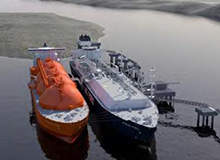

The Klaipeda LNG Terminal, which had been under construction since late 2012, was commissioned in December 2014. The project has increased the number of gas suppliers in Lithuania, which currently imports gas solely from Gazprom.
The development plan and strategic environmental assessment report for the project was approved in December 2011, and Klaipedos Nafta was appointed by the government of Lithuania in July 2010 to oversee the development of the LNG terminal and subsequently operate it.
Other partners in the project include the Klaipeda Science and Technology Park, Klaipeda State Seaport Authority, Klaipeda Shipping Research Centre, Wismar University of Applied Sciences, ATI erc, Maritime University of Szczecin, Blekinge Institute of Technology, and Maritime Development Center of Europe.
The LNG terminal design incorporates a floating liquefied gas storage and regasification unit (FSRU), a 450m-long jetty, a gas export pipeline, and a metering station. The terminal is estimated to regasify one billion cubic metres of gas in its first year of operation, and the capacity is expected to ramp up to two to three billion cubic metres in the near future. Klaipėdos Nafta plans to construct a distribution station by 2016.
Iberdrola Ingeniería has taken up the construction of a combined cycle type power plant for government-owned Lietuvos Elektrine in Lithuania.
The project site is located on the southern part of the non-freezing Port of Klaipeda, near Kiaules Nugara (Pig’s Back) Island. The country is expected to save approximately LTL2.5bn (approximately $931m) over a period of ten years by importing gas through the terminal.
Klaipėda LNG terminal details
The FSRU receives gas from LNG carriers, stores it and regasifies it. The gas export pipeline, which is connected to the metering station and the main grid, is 18km-long and 700mm in diameter. A 3km-long section is located underground in the Curonian Lagoon. Horizontal drilling technology was employed for drilling the underground sections.
The jetty, located in the southern part of Klaipeda Seaport, comprises facilities, including a high-pressure platform, a 30m-long and 24m-wide service platform, berthing and mooring platform, catwalks, fire-fighting towers, a control room, fire warning equipment, high-pressure loading arms, and ancillary facilities.
Details of Independence FSRU
The Independence FSRU has been leased from Höegh LNG for a period of ten years, with the option to purchase after the completion of the lease period. The construction of the vessel started in September 2012 and christening was held in February 2014.
The FSRU has a storage capacity of 170,000m³, an unloading/reloading capacity of 9,000m³ an hour from the LNG carriers using flexible hoses, and a pumping capacity of 11 million cubic metres a day.
The FSRU is 294m-long, 46m-wide, and has a draft of 12.6m. Powered by four engines with a combined power of 29MW, the vessel can sail at a maximum speed of 18kt.
Gas suppliers to the LNG terminal in Lithuania
The natural gas supply operations for the terminal are managed by LITGAS. The main gas supplier for the terminal is Cheniere Energy. Statoil has also agreed to supply 540 million cubic metres of natural gas a year to the LNG terminal.
Contractors involved in the Lithuanian LNG project
Höegh LNG awarded the construction contract for the FSRU to Hyundai Heavy Industries (HHI). The contract for the supply of the FSRU’s LNG regasification unit was awarded to Wärtsilä Hamworthy, who worked in collaboration with Sinopacific Offshore and Engineering (SOE).
The LTL93.88m (approximately $35m) engineering, procurement and construction (EPC) contract for the jetty, including the terminal equipment was awarded to BMGS, whereas the LTL94.84m (approximately $35.32m) EPC contract for the pipeline was awarded to PPS Pipeline Systems.
Flour was chosen in June 2011 to serve as the project adviser. The environmental impact assessment for the project was performed by Sweco Lietuva. The mooring system for the FSRU was supplied by Trelleborg Marine Systems.
Marimatech supplied its products, including viking hooks for the jetty with remote release and mooring load monitoring system, laser docking system for the jetty, portable pilot system for the pilots on the LNG carriers, and environmental monitoring system along with Dockmaster software to be integrated to the mooring system.
Van Oord was involved in deepening the channel by about 14.5m in the water area and by up to 16m along the Kiaules Nugara island, to facilitate shipping activities at the terminal site.
Financing the Klaipėda LNG terminal project
A long-term loan of €87m (LTL300m, approximately $112m) for the project was provided by the European Investment Bank (EIB), while Nordea Bank also provided a loan of LTL120m (approximately $45m).




